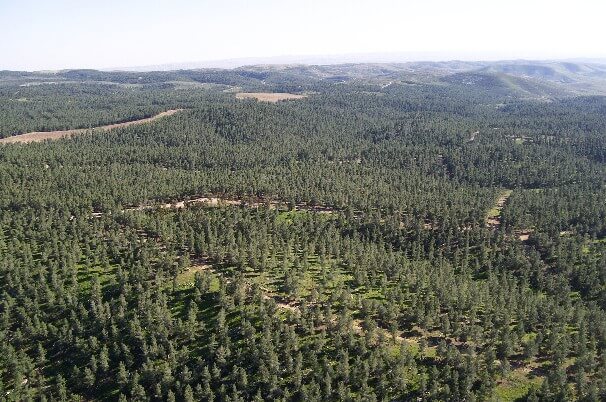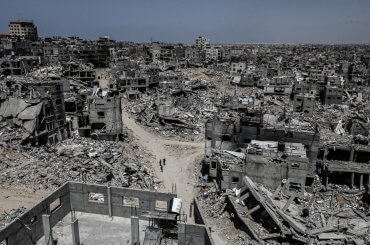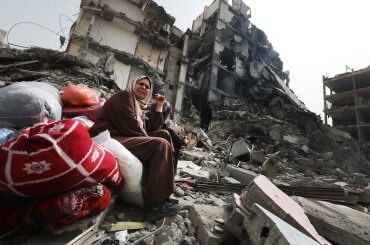Ilan Pappe’s October 25 lecture in Chicago, “The Ongoing Nakba,” promoting his new book, The Idea of Israel: A History of Power and Knowledge, emphasized two things that stood out to me in particular: Israel’s importing of European pine trees and the ethnic cleansing of Palestinians. [1] Though these issues are not new to the discourse on Palestine, Pappe reminds his audience that the land is as alive as the indigenous people who inhabited it. The mind, body, and spirit of both land and people are still victims to Israel’s current goal of de-Arabizing Palestine, “which has gotten worse for the Palestinians every year since 1882.”
The lecture, at the Church of Our Savior in Lincoln Park, was packed. As I looked around, I saw some familiar faces: Jewish activists, Episcopalians active in the Divestment movement, students from local colleges. The pews we sat in were so old that if someone moved his or her leg, everyone sitting on the long bench could feel it. It was an unseasonably warm October night in Chicago and the crispy fall leaves I walked on from the train to the church indicated that the city’s winter chill was coming soon.
Though the lecture was several weeks ago, one phrase that I haven’t been able to get out of my mind was when Pappe said that Israel’s goal since the 1882 First Zionist Congress was–and still is–“to have as much of Palestine as possible with as few Palestinians as possible.” This wasn’t new to me. But when I heard him repeat this sentence several times throughout the evening, I thought about my own connection to the land as dictated to me by the Jewish Zionist narrative.
I was so entrenched in this Zionist narrative that I didn’t know until years later that I was an active participant in these land politics. Using Israel as a playground–which so many American Jews did (and still do)–I was a Jew in Palestine playing in an absurd theater of colonization and appropriation. Unbeknownst to me, my love for the land was designed and scripted out as a larger plan to rid Palestine of Palestinians. Without thinking about it, we just simply called that land Israel and went on summer programs designed for us to fall in love with it–the land as a backdrop for our play.
Reading Pappe’s The Ethnic Cleansing of Palestine was the beginning of my transformation from Zionist to anti-Zionist. It took me a year to get through the book. Many nights I’d stare at it on my night-stand, pretend to ignore it looking back at me, and grab for the New Yorker instead. I’d return to it the next night, though, and pick up where I had left off, trying–painfully–to reconcile what I was reading with the Israeli propaganda I had absorbed as an ardent Zionist.

I remember my first trip to Israel at age 16 in the 1980’s, driving past the pine tree “forests” that Pappe writes about in his book. As a teenager, I didn’t know that pine trees were not native to the Middle East. I saw the forest, and I felt satisfaction that I had helped to “make the desert bloom.” As a child, I filled out the form that so many Jews filled out to plant a tree in Israel. I planted trees for my birthday and for others’ birthdays. I even planted a tree for Elie Wiesel when he had sent me a letter, responding to the one I had written him–during my phase as a teenager when I was obsessed with everything he wrote about the Holocaust–where I told him how much I loved his books. “Read as much as you can,” his letter began to me, “it is important to learn as much as possible.”
In his book, Pappe personifies the land as an organism that rejects the imported European pine trees–they are, to the land, as out of place as the white European Jewish settlers who set out to create a white European colony in the heart of Palestine. Like a splinter in a child’s finger that slowly on its own gravitates to the surface as though it knows it doesn’t belong, so too the European pine trees and Israeli efforts to colonize are rejected by the Palestinian land:
At times, the original flora manages to return in surprising ways. Pine trees were planted not only bulldozed houses, but also over fields and olive groves. In the new development town of Migdal Ha-Emek, for example, the JNF did its utmost to try and cover the ruins of the Palestinian village of Mujaydil …But this particular species failed to adapt to the local soil, and despite repeated treatment, disease kept afflicting the trees. Later visits by relatives of some of Mujaydial’s original villagers revealed that some of the pine trees had literally split in two, and how, in the middle of their broken trunks, olive trees had popped up in defiance of the alien flora planted over them fifty years ago. (227-228)
The land of Palestine feels and recognizes foreign bodies. During subsequent trips to Israel, driving past the forests, I saw some of those trees bought with my allowance money as a child. I didn’t see the indigenous earth and plants beneath, of course, rejecting efforts to colonize it, the land itself personified before me now in Pappe’s book.
I remember, as a little girl, the pride I felt when I received the certificates for planting trees. When the certificate for the tree I planted for Elie Wiesel arrived in the mail, I sent it to him at Boston University. Now, my JUF certificates for planting trees sit next to a certificate I received from Daoud Nassar’s Tent of Nations when I planted an olive tree at his home in the West Bank. The certificate says, “The Tent of Nations seeks to bring people of various cultures together to build bridges of understanding, reconciliation, and peace.” Looking at them side-by-side, I don’t feel any better. Pappe’s lecture reminded me that I’m not supposed to.
At the end of his talk, Pappe reiterated that the only thing that can come out of Zionism is racism. Then he went on to say–no easy task–that Zionism nevertheless produced great achievements. “It saved my family. It revived the Hebrew language,” he said solemnly, while reminding us–for the last time this evening–of Zionism’s main goal: to have as much of Palestine as possible, with few Palestinians as possible.
Notes
1. Pappe spoke as the keynote speaker at the annual conference of the Israel Palestine Mission Network of the Presbyterian Church (USA).



“Later visits by relatives of some of Mujaydial’s original villagers revealed that some of the pine trees had literally split in two, and how, in the middle of their broken trunks, olive trees had popped up in defiance of the alien flora planted over them fifty years ago. (227-228)”
Mother nature protecting herself from unnatural intrusions.These images would make great posters on America,s railway platforms , educating people on just how ” Out of place” zionist incursions are in Palestine.
Pamela Geller would surely have a hissy fit trying to come up with a response.
Thanks for this article.One of the best I have seen here.
This is how these terrorists operate. They have no regard for other religions or Holy places of worship. They are the scum of the earth and they keep getting away with it:
“Ten torched mosques, zero indictments
Since June 2011, 10 mosques in Israel and the West Bank have been set on fire by presumed right-wing Jewish extremists. No charges have been filed.
Wednesday’s torching of a mosque in the Palestinian village of al-Mughayyir brings to 10 the number of Muslim houses of worship in Israel and the territories that have been targeted in arson attacks in less than three and a half years. No one has been charged in any of these incidents.”
Haaretz
Racists. Evil….Israel’s terrorists.
thank you so much liz.
I’ve just come back from listening to Prof. Pappe give a talk in Dublin.
I even got him to sign my copy of his book.
That made my day!
A very moving essay.
FYI – the Tent of Nations is no more. I read that the IDF arrived and cleared the site. Here is what it was like two years ago.
For a more comprehensive and personal look at the Tent of Nations, Diana Alzeer paid a visit in 2010 as part of the Sleepless in Gaza and Jerusalem series. Go to 3:30 in.
I attended Pappe’s lecture as well and what struck me was his insistence that there are no chapters in Zionism, that what is going on today is a logical progression from the very first efforts of Zionists in the 19th century.